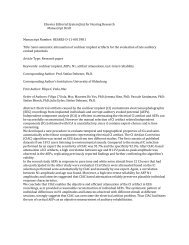Acoustic Signatures of Three Marine Arthropods, Squilla mantis ...
Acoustic Signatures of Three Marine Arthropods, Squilla mantis ...
Acoustic Signatures of Three Marine Arthropods, Squilla mantis ...
Create successful ePaper yourself
Turn your PDF publications into a flip-book with our unique Google optimized e-Paper software.
strength for another 0.3 ms (Figures<br />
4A and 5A). The spectrogram<br />
for S. <strong>mantis</strong> for the 180° aspect displays<br />
three closely spaced reverberations followed<br />
by weaker reverberations lasting<br />
for 0.3 ms (Figures 6A and 7A).<br />
H. americanus, the American lobster,<br />
displays fewer strong absorption<br />
bands on the left-hand side than on<br />
the right-hand side. As is normal, the<br />
left-hand claw <strong>of</strong> this specimen was<br />
modified as a crushing claw, which is<br />
much stronger and larger than the<br />
right-hand tearing claw. Except for<br />
the right posterior quarter and righthand<br />
side, all <strong>of</strong> the absorption bands<br />
are relatively narrow. In general, the<br />
acoustic signature <strong>of</strong> H. americanus<br />
was much stronger than that <strong>of</strong> the preceding<br />
specimens (Figures 2B and 3B).<br />
The spectrogram for the 0° aspect<br />
shows a strong narrow band followed<br />
by a weaker band about 30% <strong>of</strong> the<br />
maximum, reverberation arriving in<br />
the following 0.05 ms (Figures 4B<br />
and5B).Between0.2and0.3ms<br />
after the initial signal arrives, a much<br />
weaker signal, 10% to 15% <strong>of</strong> the initial<br />
target strength, arrives. The latter<br />
may either come from internal reflections<br />
or the uropods and telson. The<br />
frequency versus time spectrogram<br />
for the 180° aspect showed a very strong<br />
initial reverberation quickly, followed<br />
by reverberations about 30% <strong>of</strong> the initial<br />
intensity during the first 0.1 ms<br />
(Figures 6B and 7B). There are relatively<br />
weak,
















